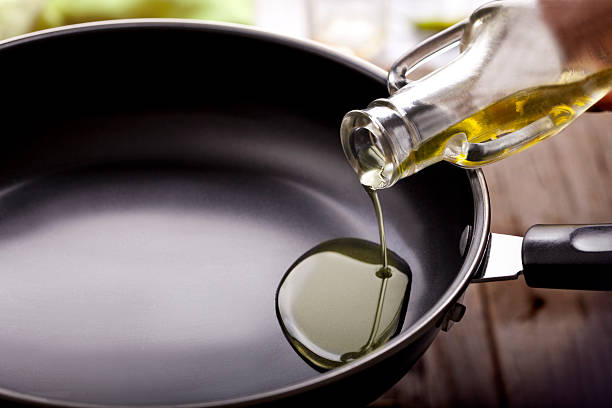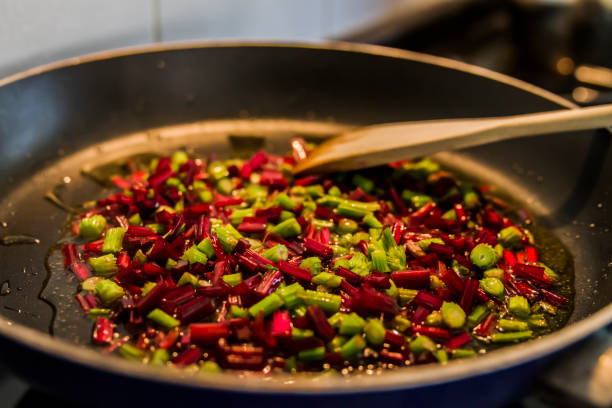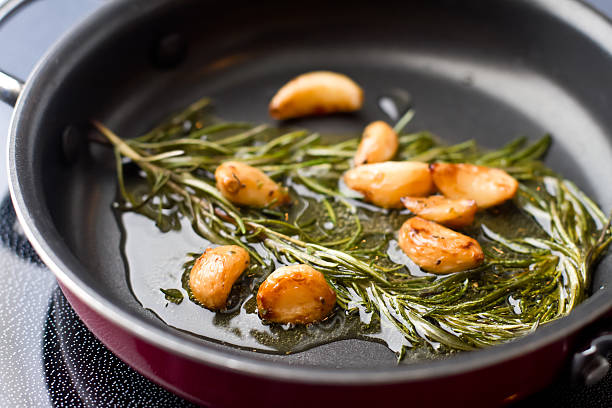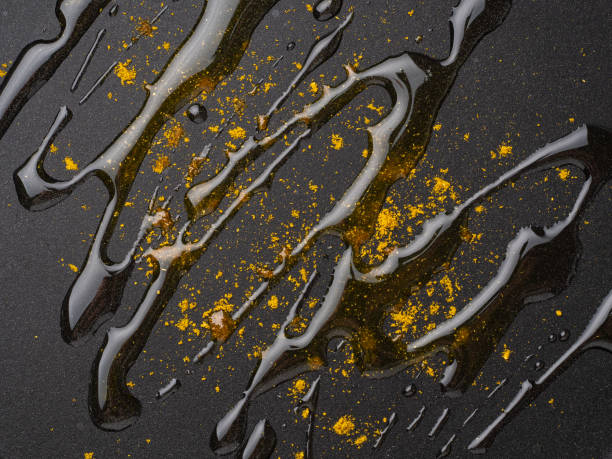In the sizzling world of culinary wonders, where the clash of flavors and aromas takes center stage, the debate over whether non-stick pans need a slick of oil has sparked a gastronomic intrigue.
Like a seasoned chef navigating the kitchen dance floor, we find ourselves pondering the age-old question: To oil or not to oil?
As the culinary canvas evolves, so does the artistry of cookware, and in the realm of non-stick pans, the question transcends mere kitchen etiquette to become a culinary conundrum.
Join us on a journey through the sizzling labyrinth of non-stick wonders, as we unravel the mysteries of oil and its dance with the shimmering surfaces of these modern kitchen companions.

Do Non Stick Pans Need Oil
Yes, non-stick pans benefit from a light application of oil, enhancing their performance and extending their lifespan.
When it comes to culinary convenience, non-stick pans have become indispensable in kitchens worldwide. But the question looms: Do non-stick pans need oil? Let’s delve into the nuances of this culinary quandary, exploring the relationship between non-stick cookware and the use of oil.
Understanding the Dynamics
Navigating the landscape of non-stick cookware requires a grasp of its intricate dynamics. While non-stick surfaces provide a slick foundation for cooking without the hassle of stubborn residue, a judicious use of oil can elevate the cooking experience.
The notion that non-stick pans need oil is rooted in the desire to enhance both flavor and texture while ensuring the longevity of these kitchen essentials.
Optimizing Performance
In the realm of cooking, performance is paramount. To optimize the capabilities of non-stick pans, a thin layer of oil acts as a culinary ally.
It facilitates even heat distribution, preventing hotspots that might compromise the quality of your culinary creations. This synergy between non-stick surfaces and oil underscores the importance of balance in the kitchen.
Enhancing Flavor and Texture
Food aficionados often extol the virtues of using oil in non-stick pans to impart an extra layer of flavor and achieve a desirable texture.
From sautéed vegetables to perfectly seared meats, the judicious application of oil not only prevents sticking but also elevates the overall gastronomic experience. It’s a delicate dance between the non-stick prowess and the flavorful touch of oil.
Prolonging Lifespan
Non-stick pans are an investment in culinary convenience, and like any investment, proper care ensures a longer lifespan. The judicious use of oil acts as a protective shield, preventing wear and tear on the non-stick coating.
This simple practice not only enhances the durability of the pan but also safeguards its non-stick properties, ensuring that it remains a reliable kitchen companion.
Understanding Non-Stick Coatings
Types of Non-Stick Coatings
1. PTFE (Polytetrafluoroethylene)
PTFE, commonly known as Teflon, is a synthetic polymer widely used as a non-stick coating. This material is known for its exceptional heat resistance and low friction properties.
PTFE coatings are applied to cookware surfaces to prevent food from sticking during cooking. The smooth and slippery nature of PTFE helps in easy food release and facilitates effortless cleaning.
2. Ceramic Coatings
Ceramic non-stick coatings are made from inorganic materials like silica and clay. These coatings offer a natural alternative to PTFE and are celebrated for their eco-friendly characteristics.
Ceramic coatings provide a smooth surface with good non-stick properties, making them popular in various cookware applications. They are often chosen for their scratch resistance and ability to withstand high temperatures.
3. Seasoned Cast Iron
Seasoned cast iron pans utilize a different approach to achieve non-stick properties. Instead of applying a synthetic coating, these pans are seasoned with oil and baked to create a natural non-stick surface.
Over time, this seasoning builds up, enhancing the non-stick performance. Seasoned cast iron is known for its durability and ability to withstand high heat, making it a favorite among chefs for various cooking methods.
How Non-Stick Coatings Work
Non-stick coatings, regardless of the type, function on the principle of reducing surface friction. This is achieved through the following mechanisms:
1. PTFE Lubrication
PTFE, being a fluoropolymer, creates a slippery surface that minimizes friction between the pan and food. This low friction property prevents sticking, making it easier to cook and clean. The stability of PTFE under high temperatures ensures its effectiveness in various cooking scenarios.
2. Ceramic Smoothness
Ceramic coatings utilize the smoothness of inorganic materials to create a non-stick surface. The microscopic particles in the coating contribute to a slick and even surface, preventing food from adhering. Additionally, ceramic coatings often resist scratches and provide a visually appealing cooking surface.
3. Natural Seasoning of Cast Iron
Seasoned cast iron pans rely on the natural development of a non-stick surface through the process of seasoning. The application of oil and subsequent baking creates a layer that not only prevents sticking but also imparts a unique flavor to the food. This method requires ongoing maintenance to ensure the longevity of the non-stick properties.

Do Non-Stick Pans Require Oil?
Factors Influencing the Need for Oil
1. Type of Non-Stick Coating
The necessity of using oil in non-stick pans depends significantly on the type of coating. PTFE (Teflon) and ceramic coatings generally allow for cooking with minimal or no oil due to their inherent non-stick properties. In contrast, seasoned cast iron, while naturally non-stick, may benefit from occasional oiling to maintain its seasoning and enhance its performance.
2. Cooking Temperature
Cooking temperature plays a crucial role in determining whether oil is required. Higher temperatures can challenge the non-stick properties of certain coatings. While PTFE remains stable at high temperatures, ceramic coatings may benefit from a light coating of oil to prevent sticking, especially when cooking at elevated heat levels.
3. Type of Food Being Cooked
The nature of the food being prepared is another influential factor. Foods with higher sugar content or those prone to caramelization might stick more easily. In such cases, a small amount of oil can act as a protective barrier, preventing sticking and ensuring the easy release of the cooked food.
Benefits of Using Oil with Non-Stick Pans
1. Enhancing Flavor
Applying a thin layer of oil to non-stick pans can contribute to the flavor profile of the cooked dish. Oil can carry and enhance the flavors of herbs, spices, and other seasonings, resulting in a more savory and well-rounded taste.
2. Improving Texture
Oil can play a role in achieving desirable textures in certain dishes. For instance, it can help crisp up the exterior of foods, such as vegetables or proteins, creating a pleasant contrast between a crunchy outer layer and a tender interior.
3. Preventing Sticking in Some Cases
While non-stick coatings are designed to minimize sticking, there are instances where a light coating of oil is beneficial. This is particularly true when dealing with delicate or sticky foods. The oil acts as a lubricant, reducing the chances of the food adhering to the pan surface.
Proper Use and Care of Non-Stick Pans
Guidelines for Cooking with Non-Stick Pans
1. Preheating Recommendations
Preheating non-stick pans is essential for optimal performance. However, it’s advised to avoid excessive preheating, especially when dealing with PTFE (Teflon) coatings, as prolonged exposure to high heat can compromise the non-stick properties. A moderate preheating temperature is generally sufficient for even cooking without causing damage to the coating.
2. Choosing the Right Cooking Oil
When using oil with non-stick pans, opt for oils with high smoke points, such as vegetable or canola oil. These oils are less likely to break down at higher temperatures, preventing the formation of residue that can impact the pan’s non-stick surface. Additionally, use oils sparingly to avoid excessive buildup on the pan.
3. Avoiding High Heat
Non-stick pans are designed to excel at low to medium heat settings. Avoid cooking at excessively high temperatures, as this can lead to the breakdown of the non-stick coating. It’s recommended to adjust heat settings according to the manufacturer’s guidelines and the type of non-stick coating to ensure longevity and optimal performance.
Cleaning and Maintenance
1. Hand Washing vs. Dishwasher
To prolong the life of non-stick pans, hand washing is generally recommended. Use a soft sponge or cloth with mild dish soap to gently clean the pan. Avoid abrasive scrubbers and harsh dishwasher detergents, as they can erode the non-stick coating over time. If dishwasher use is unavoidable, choose pans specifically labeled as dishwasher-safe and follow the manufacturer’s instructions.
2. Using Appropriate Utensils
Employ utensils made from silicone, wood, or nylon when cooking with non-stick pans. These materials are gentle on the non-stick coating, minimizing the risk of scratches and damage. Refrain from using metal utensils, as they can scratch the surface and compromise the non-stick properties of the pan.
3. Avoiding Abrasive Cleaners
Harsh and abrasive cleaners, including scouring pads and powders, should be avoided when cleaning non-stick pans. These can scratch and wear down the coating, diminishing its effectiveness. Instead, opt for non-abrasive cleaning tools and mild detergents to maintain the pan’s non-stick performance.

Common Myths and Misconceptions
Myth: Never Use Oil with Non-Stick Pans
One prevalent misconception is that oil should never be used with non-stick pans. In reality, while non-stick coatings are designed to reduce the reliance on excessive oil, using a minimal amount of oil can be beneficial.
Oil can enhance the flavor of the food, improve texture, and, in some cases, aid in preventing sticking. The key is moderation—using too much oil can lead to a buildup on the pan and affect its non-stick properties over time.
Choosing oils with high smoke points is also crucial to prevent the oil from breaking down and leaving residues.
Myth: Non-Stick Coatings Are Indestructible
Contrary to the belief that non-stick coatings are invincible, they are not indestructible. While these coatings provide excellent non-stick properties, they can wear down over time, especially if subjected to harsh conditions.
Factors such as high heat, the use of metal utensils, and abrasive cleaning tools can contribute to the degradation of non-stick coatings. It’s important to follow the manufacturer’s guidelines for proper use and care to maximize the lifespan of non-stick pans.
Regularly inspecting the condition of the coating can also help identify signs of wear and prompt timely replacement if necessary.
Addressing Safety Concerns
Some concerns have been raised regarding the safety of non-stick coatings, particularly those containing PTFE (Teflon).
The primary safety concern arises when PTFE is subjected to extremely high temperatures, leading to the potential release of fumes that can be harmful to birds and cause flu-like symptoms in humans (known as polymer fume fever).
However, when used within recommended temperature ranges during cooking, PTFE-coated pans are considered safe. Additionally, the availability of alternative coatings like ceramic and seasoned cast iron provides options for those seeking non-stick cookware without PTFE.
It’s essential to be aware of the specific safety guidelines for each type of non-stick coating and use them accordingly to ensure a safe and enjoyable cooking experience.
Alternatives to Oil with Non-Stick Pans
Cooking Sprays
Cooking sprays are convenient alternatives to liquid oils when using non-stick pans. These sprays typically contain a minimal amount of oil and are designed to provide a light and even coating on the pan surface.
Cooking sprays are available in various formulations, including olive oil, canola oil, and non-stick cooking sprays specifically designed for use with non-stick cookware. It’s important to use cooking sprays in moderation to avoid residue buildup on the pan.
Butter and Margarine
Butter and margarine can also be used as alternatives to oil when cooking with non-stick pans. These fats add flavor to dishes and contribute to a rich texture. However, it’s important to use them in moderation, as excessive amounts can lead to residue buildup on the pan.
Butter and margarine have lower smoke points compared to some oils, so care should be taken to prevent them from burning at high temperatures, which could affect the non-stick coating.
Cooking Without Any Added Fat
Non-stick pans are designed to minimize the need for added fats, making it possible to cook certain foods without using any oil or fat at all. This is particularly suitable for dishes that release their own natural juices or for individuals seeking lower-fat cooking options.
When cooking without added fat, it’s important to monitor the heat level to prevent sticking, especially when dealing with foods prone to adhering to surfaces.
Environmental and Health Considerations
Impact of Non-Stick Coating Production
The production of non-stick coatings, particularly those containing PTFE (Teflon) or other synthetic materials, has raised environmental concerns. The manufacturing process of these coatings involves the use of certain chemicals that may have environmental implications.
Additionally, disposal of cookware with worn-out non-stick coatings poses challenges. To address these concerns, there has been a growing interest in the development of eco-friendly alternatives, such as ceramic coatings, which often have a lower environmental impact.
Consumers interested in minimizing their environmental footprint can explore cookware options that prioritize sustainable and eco-friendly manufacturing practices.
Health Concerns Associated with Overheating Non-Stick Pans
Overheating non-stick pans, especially those with PTFE coatings, can pose health risks. When subjected to extremely high temperatures, PTFE can release fumes that may be harmful if inhaled.
This phenomenon, known as polymer fume fever, can cause flu-like symptoms in humans and is a concern for pet birds. To mitigate this risk, it’s essential to use non-stick pans within recommended temperature ranges and avoid overheating.
Alternative coatings like ceramic and seasoned cast iron provide options for individuals seeking non-stick cookware without potential health concerns related to PTFE.
Sustainable Practices in Non-Stick Cookware Usage
Adopting sustainable practices in the use of non-stick cookware can contribute to minimizing environmental impact. Some practices include:
- Proper Care and Maintenance: Regular maintenance and proper care of non-stick pans can extend their lifespan, reducing the frequency of replacements and associated waste.
- Choosing Sustainable Materials: Opting for non-stick cookware made from sustainable materials, such as responsibly sourced cast iron or cookware with eco-friendly ceramic coatings, aligns with environmentally conscious choices.
- Recycling and Responsible Disposal: When it’s time to replace non-stick cookware, exploring recycling options or choosing cookware with recyclable components can contribute to reducing waste.
- Supporting Eco-Friendly Brands: Choosing cookware from brands committed to sustainable and environmentally friendly practices can help promote responsible manufacturing in the industry.

FAQs
Q: Do non-stick pans require oil for cooking?
A: Absolutely not! Non-stick pans are designed to provide a seamless cooking experience without the need for excessive oil. They feature a special coating that prevents food from sticking, allowing you to cook with minimal oil for a healthier option.
Q: Can I cook without oil in a non-stick pan?
A: Certainly! Non-stick pans excel at low-fat cooking. You can easily prepare delicious meals with little to no oil, making them an excellent choice for those aiming to reduce their calorie intake or adopt a healthier cooking style.
Q: How does a non-stick pan perform without oil?
A: Exceptionally well! The non-stick coating on these pans ensures that food effortlessly slides off the surface, even without the use of oil. This not only makes cooking easier but also promotes a cleaner, fuss-free kitchen.
Q: Is it possible to achieve a golden sear without oil in a non-stick pan?
A: Absolutely! Non-stick pans are versatile and can still deliver a perfect sear without the need for excessive oil. They distribute heat evenly, allowing you to achieve that coveted golden crust on your favorite dishes.
Q: Are non-stick pans a healthier alternative when it comes to oil usage?
A: Yes, indeed! Non-stick pans promote healthier cooking by reducing the amount of oil needed. This feature is especially beneficial for individuals looking to maintain a balanced diet without compromising on flavor or texture.
Q: Can I use non-stick pans for various cooking techniques without oil?
A: Certainly! Non-stick pans are incredibly versatile and can be used for a wide range of cooking techniques, from sautéing and frying to baking, all with minimal to no oil. Their adaptability makes them a kitchen essential for any culinary enthusiast.
Q: Do non-stick pans make cleaning up easier when cooking without oil?
A: Absolutely! Since food is less likely to stick to the surface, cleaning non-stick pans is a breeze, even when cooking without oil. This convenience saves both time and effort in the kitchen.
Q: Are there any specific tips for cooking without oil in a non-stick pan?
A: Certainly! While non-stick pans make it easy to cook without oil, it’s advisable to use low to medium heat and avoid using metal utensils to prolong the life of the non-stick coating. With proper care, your non-stick pan can continue to deliver excellent results without the need for excess oil.
Q: Can I use non-stick pans for cooking delicate items without oil?
A: Absolutely! Non-stick pans are perfect for cooking delicate items like fish or eggs without the risk of sticking. The non-stick surface ensures that your culinary creations release effortlessly, maintaining their shape and presentation.
Q: Are there any benefits to cooking without oil in a non-stick pan?
A: Certainly! Cooking without oil in a non-stick pan not only reduces calorie intake but also allows the natural flavors of your ingredients to shine. It’s a healthier option that doesn’t compromise on taste or texture, making your meals both delicious and nutritious.
Conclusion
In conclusion, the question of whether non-stick pans need oil is nuanced and depends on various factors.
While non-stick coatings are designed to reduce the need for excessive oil, incorporating a small amount can enhance cooking performance and prevent potential damage to the coating over time.
It’s crucial to strike a balance, using oil sparingly to maintain the non-stick properties of the pan without creating a sticky residue. Moreover, the type of non-stick coating and the specific cooking requirements play a role in determining the necessity of using oil.
Ultimately, understanding the unique characteristics of non-stick pans and adapting cooking practices accordingly ensures both effective food preparation and the longevity of these kitchen essentials.
Other Articles You May Also Like:
- Best Oil For Seasoning Cast Iron (5 Pro Recommended)
- Is It Safe To Put Aluminum Foil In Frying Pan (6 Helpful Reasons)
- Can You Deep Fry In Nonstick Pan (5 Things You Should Know)
- What Can You Cook In Stainless Steel Pans (5 Things You Should Know)
- Can Non Stick Pans Go In The Oven (7 Cool Facts)
- How To Make A Ceramic Pan Non Stick Again (6 Essential Steps)
- How Long Do Non Stick Pans Last (3 Eye-opening Things To know)